De gustibus non disputandum – Cicero
In this article, after a brief description of garum and its history, a preliminary experiment based on Martialis’ recipe provides a taste of past.
When Rome came into contact with the Greek world, a great amount of information, culture, technology and grandeur entered the then rural roman way of living.
It is in fact from the second half of the III century BC that Greek influence in many aspects of life was acknowledged by the ancient authors.
Among these, we find influences on cuisine and cooking. Garon, as it was known among the Greeks, was a culinary preparation made mainly of fish, salt and herbs and was in use in Greek cuisine from at least the 5th century BC (Pliny, NH XXXI, 93). The production and trading of garum lasted for at least one millennium: its taste could be called a golden thread of the Ancient World.
But what was it like? And, more importantly, what was it that made it taste like itself? It is to answer these questions that this project came to life. In this article we will illustrate the first steps taken for searching the answers. The analysis needs to be carried on deeper and wider, many written sources have to be read (and found!), many archaeological finds are there to be researched: we are perfectly aware of the fact that this is just a beginner’s log.
A brief history of garum production, fortune and trade will be given in the first part. In the second part methodology and specific information from written sources will be discussed and in the third the preliminary experiment will be illustrated.
In the conclusions problems, variables and further experiments will be analysed.
In his Liber de Agricultura Cato (between the 3rd and 2nd century BC) refers to allec, which seemed to have been a paste obtained by the working of fish, herbs and salt.
The etymology of such a term appears to find its roots in the word putrescence (Dosi, Schnell 1984: 181). Interestingly, he refers to it when describing food needed by the family who run a rural farm once the olives run out (Cato, LVIII).
Because of the amount of nutritive substances (such as amino acids, nitrogen, and many different trace elements), garum and allec were quite important in the mainly vegetarian diet of ancient Rome (Hubert 2001).
Garum was a liquid or semi liquid sauce obtained by the decomposition of fish and herbs in salt. According to Pliny, it was at first obtained from one selected kind of fish which might be compared to anchovies. Common garum, on the contrary, was created by the decomposition of fish entrails in salt. Its exotic taste entered firmly into the roman world in the time of Apicius and was considered a fundamental ingredient to many recipes. The liquid garum (another term used to indicate it is liquamen) was so popular that it was also added to fruit jams (Dosi, Schnell 1984: 210).
Many archaeological remains witness the importance of the product.
The Atlantic coast of Spain and Morocco, as well as the Mediterranean coasts and the Black Sea were sites of production of garum. The centres of industry in the transformation of fish, in which tuna and other fish was cleaned and salted, were also the sites in which salt was extracted (see Purpura 1982). These industries consisted of a series of cocciopesto (lime mortar with crushed pottery) covered vats (called cetaria) in which the fish was worked and, probably, entrails, salt and herbs were left in the sun for transformation into garum. Usually, amphorae sherds found nearby the vats help to give an idea of the duration of the production. The most famous garum was made only with mackerel and was produced in Spain (Pliny NH XXXI, 94) and sold all over the empire in Dressel 7-9 amphorae (Purpura 1982). The north African coast was rich in this sort of industry which produced a typical amphora to contain the sauce. The African amphorae sherds for garum trade can be found across the empire from Severian times and a sign of change in the market trends of that time (Purpura 1982).
Thiis mode of production is not so common on the Tyrrhenian coast of Italy. Scholars believe the reason for this can be found in the garum officina (garum’s factory) found in Pompeii. Even though Pliny acknowledges Pompeii as a famous site for the production of garum (NH XXXI, 95), the witnessed procedure differs slightly from the others. Here the mixed ingredients were left to ferment in dolia, not in vats, but were sold in amphorae as the other garum (Salza Prina Ricotti 1999).
An interesting note of the edictum de pretiis by Diocletian (301 AD) states two different prices for the first liquamen and the second liquamen (III, 7), probably reflecting a difference in quality.
The production of garum was carried on until the 5th century AD in Morocco, and the consuming of garum is witnessed into the early medieval times and later (8th century AD, Salza Prina Ricotti 1999, Purpura 1982 footnote 10; Encyclopaedia Romana under “Garum” states that there is trace of production of garum as late as 1345 AD).
It seems therefore that production of garum was strictly linked with the industry of fish transformation: it actually used the same facilities. But this is not the only production witnessed as another method used dolia to obtain the same product.
Th e curiosity about the taste of such a famous and renown ingredient lead us to approach garum from the experimental perspective. The first aim of our experiment was to be able to evaluate variables which may affect garum’s taste. To attempt a reconstruction of a “taste” might be considered as rather an impossible mission. Experimental archaeology has already demonstrated in the past decades how an “accurate” reconstruction is not only impossible to obtain, but also does not necessarily improve our knowledge of the past. We can imagine, therefore, how subtle the results could be when the object of the experiment is not an object but a taste, which certainly lacks both materiality and assessment measurements which can aid the evaluation. This theme has entered many times into the discussion of those who participated in the experiment, and lead sometimes to a great discouragement for the task. Even so, after having eviscerated the problem in many ways, we decided that experimental methodology could be a great help in such an attempt. The preliminary experiment on garum production was therefore planned to assess the variables and their consequent relationship. An organoleptic evaluation of the final product was programmed to have a standardised description of the taste, useful to provide a comparison for further experiments.
As the starting point should be the archaeological record but we did not find any convincing sources and studies made on the subject.
In popular books the stereotypes of garum being a putrescent and morbid thing were not sustained by experiment on actually making or tasting it according to the ancient procedure (Dosi, Schnell 1984: 28, 246). On the contrary, in the same source, the experimental approach in the creation of garum was gladly encouraged, as the importance of that ingredient was evident both by written and material sources (ibidem: 254). The information about taste was limited to a link to nuoc-mâm, an oriental preparation still in use. The origin of it were referred to as an error made in the conservation of fish, ending in some sort of not-toobad waste (ibidem: 210).
Even the ancient world seems to be split into those who liked garum and those who did not. Martial refers to garum made only with the blood of freshly killed mackerel as a sumptuous gift (Xen. XIII, 102), but points out also that common garum had a terrible smell. Apicius, on the other hand, gives a recipe to change the smell of garum with the aid of herbs and honey (Apicius De Re Coquinaria, I, 6). The first liquid was called gari flos (flower of garum). The most appreciated was called garum nigrum and was sold in small jars. The banqueters could use it as they pleased directly on the table (Dosi, Schnell 1984: 212).
As we said, allec was the remaining paste after all the liquid has been extracted, but some scholars say that originally allec was garum at the midfermentation point. In recipes allec was used as an appetiser.
At some point, it seems to become an independent preparation, as we can also read about allec made only with one type of fish or molluscs.
Let us move to consider present day information about fish sauces of that kind. As we said, nuoc mân from Vietnam and naam-pla from Thailand are the closest existing sauces to ancient garum.
To make it, fish and salt layers are alternatively put into an earthenware big jar with a percentage of 20% salt on the total. The jars are then closed with a mat and left to ferment from one to three months.
The first extracted sauce is the best quality. Then subsequently adding brine and filtering produce second and third quality choice sauce. The obtained liquid is put into glass bottles and exposed to sunlight to acquire a clear caramel colour. As it is today, different hues were associated with different qualities of sauce (see above, garum nigrum).
The process of transformation from solid to liquid, is not, as it was thought commonly, decomposition or fermentation. If the percentage of salt is kept 20% or higher, the process of fermenting stops at a certain point and gives way to what is known as autolysis, an actual maturation of the compound (Hubert 2001, Purpura 1982, footnote 7). The presence of viscera probably aids the process because of the presence of active enzymes (Rovere et al. 2008, “garum”). The knowledge of this biochemical process lead modern garum-makers to obtain good results with a yogurt-maker in which heat can be kept controlled (Wunderlich’s webpage).
An Italian product, called “Colatura di Alici”, is quite similar to the ancient garum made with anchovies collected in spring and summer, it is created by the fish being put under pressure with salt. The raw fish is cleaned of entrails and put in salt for at least 24 hours. It is then transferred to wooden barrels between layers of salt. The closing cap is then charged with extra weight and the resulting liquid collected in glass bottles and left for four or more months exposed to sunshine to gain concentration. After this, the liquid is then put again in wooden barrels with anchovies and then collected from a little opening.
It is then ready in December. Its use is traditional for Christmas’ eve on non-salted pasta (Colatura di Alici webpage).
Written sources that illustrate the “recipe” for making garum are very few and very late. No one states the quantities, and the most accurate are those of the Geoponica collection, dating to medieval times (Curtis R. I. 1991: 194). We decided therefore to start from a late source that seemed to be sufficiently clear to elaborate a proportion of the ingredients. This source comes from a collection of works made in medieval times and its supposed author is Gargilius Martialis as quoted from Dosi Schnell 1982 and Gozzini Giacosa 1992. Gargilius Martialis, a writer from the third century AD, in “De medicina et de virtute herbarum” writes:
“Use fatty fish, for example sardines, and a well-sealed (pitched) container with a 26-35 quart/litre capacity. Add dried aromatic herbs possessing a strong flavour, such as dill, coriander, fennel, celery, mint, oregano, and others making a layer on the bottom of the container; then put down a layer of fish (if small leave them whole, if large use pieces); and over this add a layer of salt two fingers high. Repeat these three layers until the container is filled. Let it rest for seven days in the sun. Then mix the sauce daily for twenty days. After that time it becomes a liquid (garum)” (Gozzini Giacosa 1992: 27).
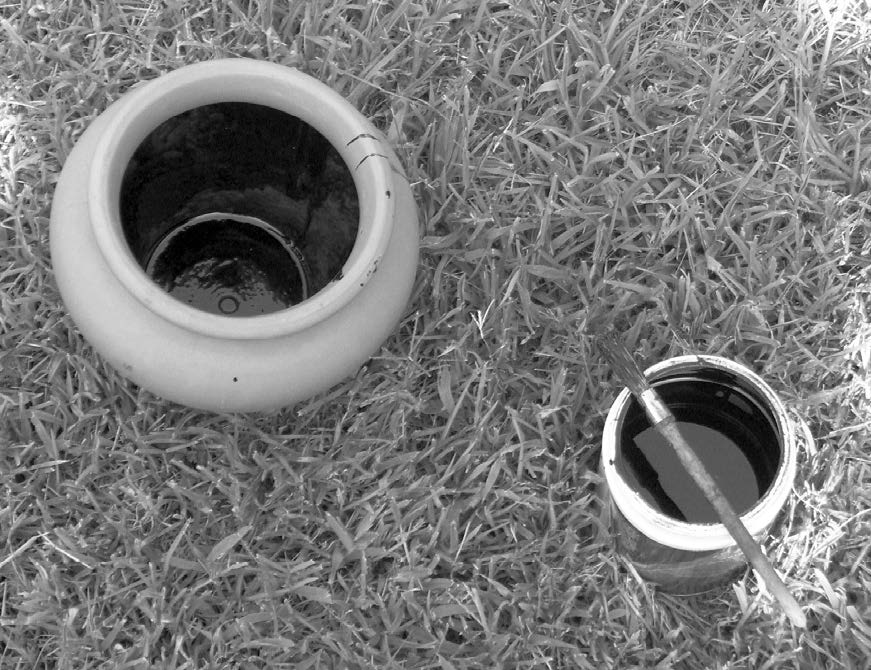
Fig. 1 Brushing the vase with pine tar
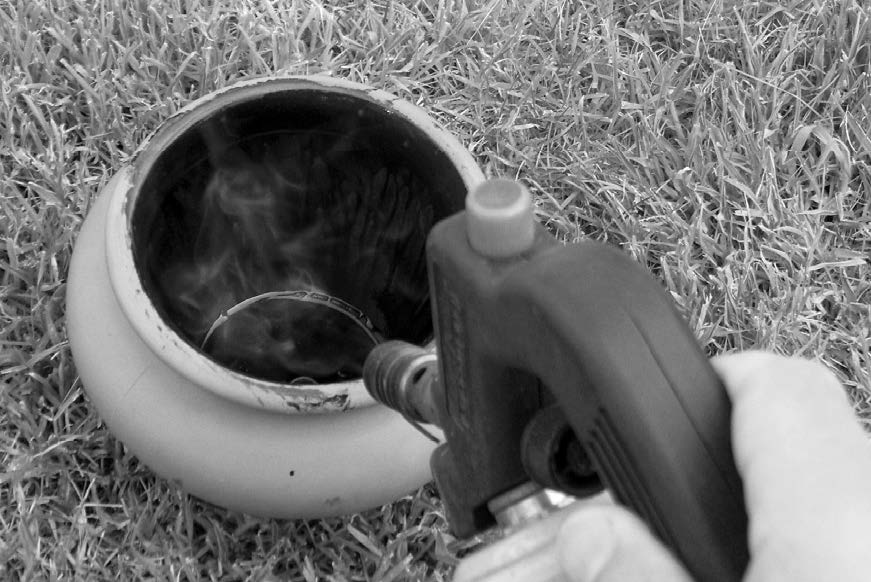
Fig. 2 Hardening the tar with a gas flame
Since our aim was to assess the variables included in the process, we decided to scale down the quantities and to adapt them from an industrial standard to a more family like method of making garum. The container used was an earthenware vase of 2,7 lt. capacity at the brim. The vase was tarred to prevent leaking (this method had been used since Cato’s times). Tar was considered an important part of the experiment, not only because of the impermeability needed for the procedure of fermentation, but also because it was thought that the resulting taste could be aff ected by the use of vegetable tar. The chosen one was natural pine tree tar, spread onto the inner surface of the vase with a brush (Fig. 1).
To harden the tar, a common flame device was used (Fig. 2).
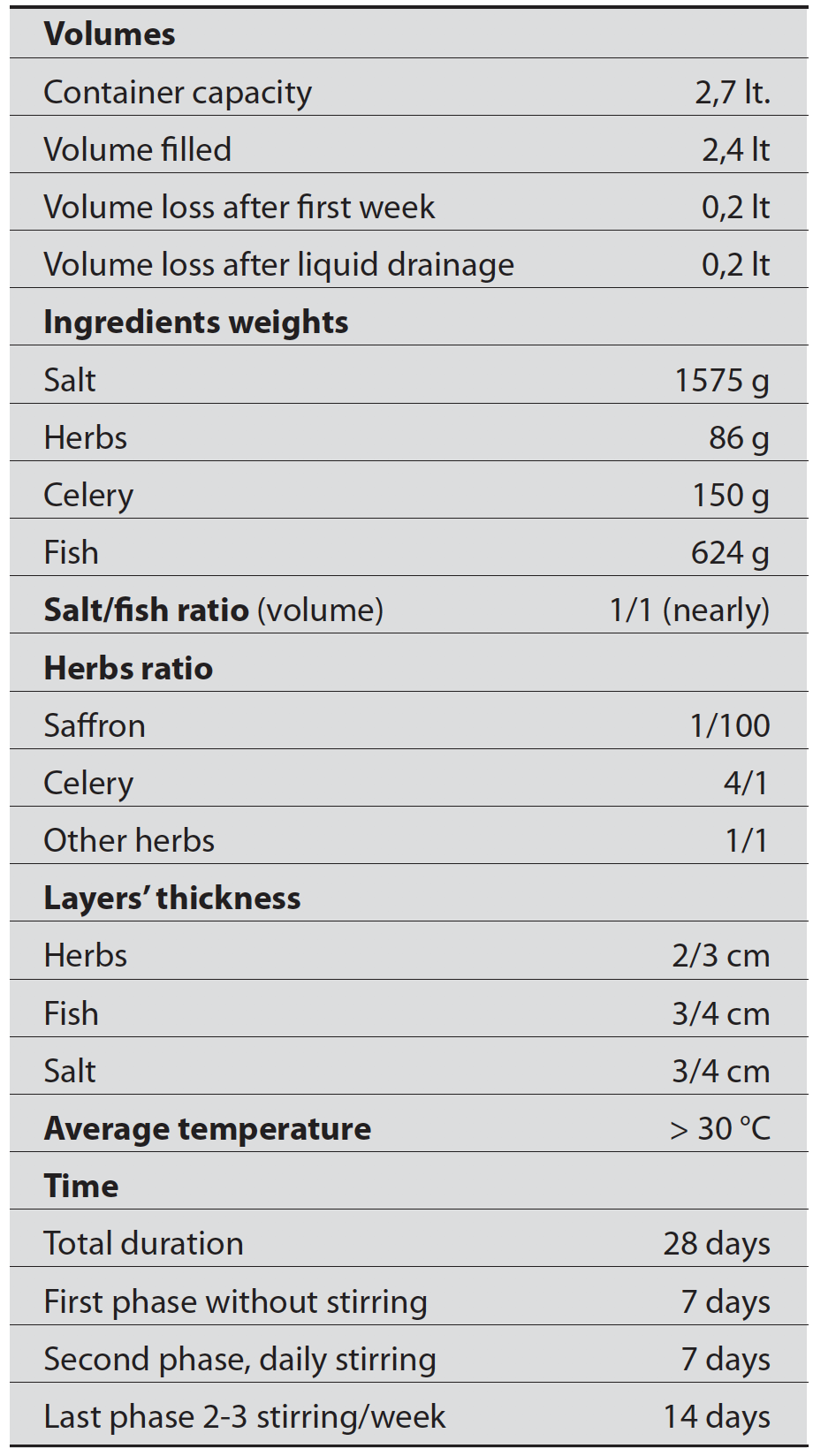
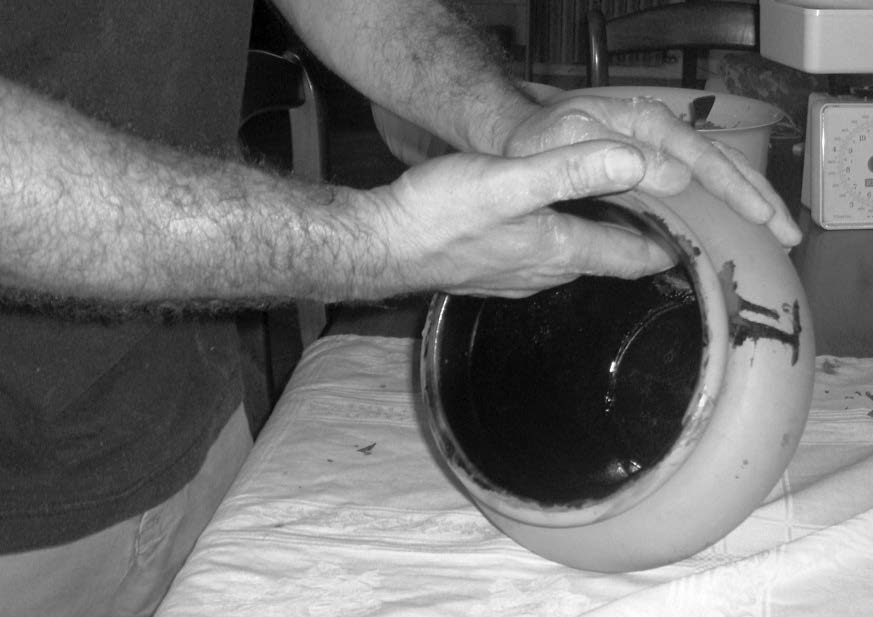
Fig. 3 A subtle olive oil layer to ensure impermeability
Subsequently, for ultra-safety of impermeability, it was isolated with a veil of olive oil (Fig. 3).
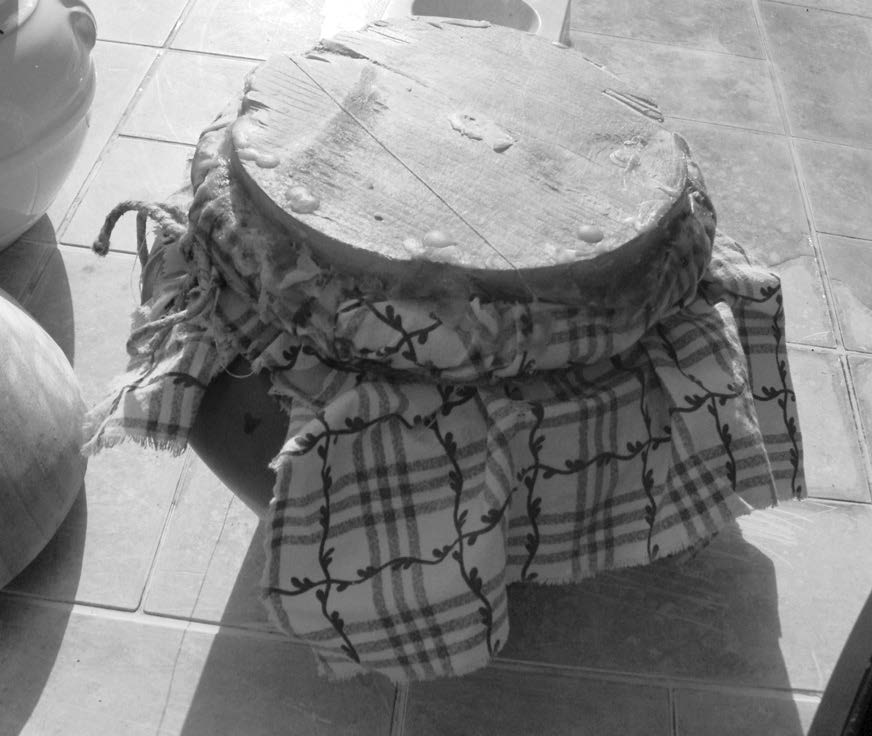
Fig. 4 Closing the vase
Subsequently, for ultra-safety of impermeability, it was isolated with a veil of olive oil (Fig. 3). During the experiment, it was clear that a soft er way of hardening the tar, possibly with embers, would have produced a more reliable result and avoided damage to the vase. To prevent insect contamination, a wooden cap wrapped with a cotton cloth was prepared to be put on the brim of the vase (Fig. 4).
Beeswax was considered to be the best material to be used to seal the cap. This system was very useful as it permitted an easy re-opening each time mixing was needed.
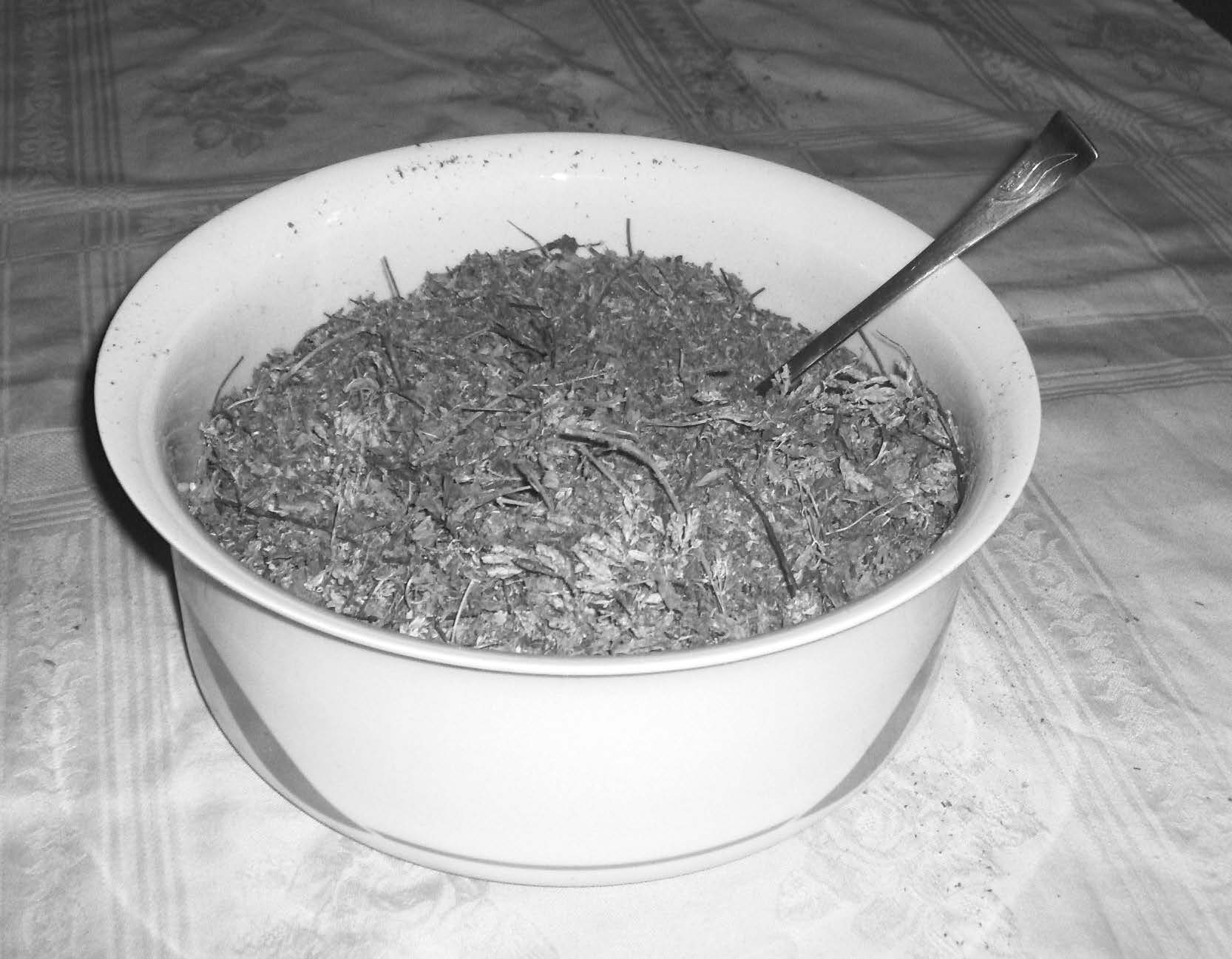
Fig. 5 Mixed dried herbs
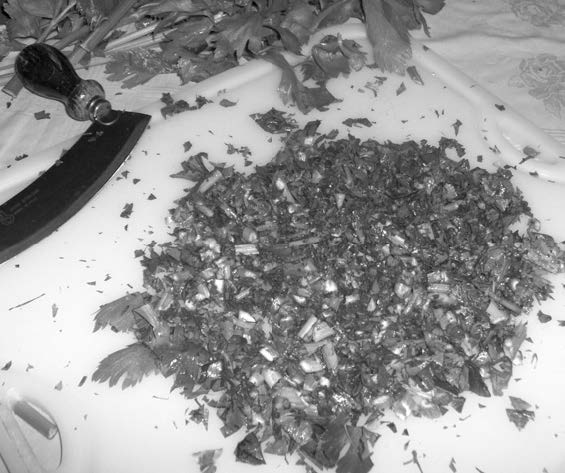
Fig. 6 Minced celery
After preparing the vase, a selection of herbs as described by Martialis was prepared.
We used:
dill (Anethum graveolens L., dried seeds),
coriander (Coriandrum sativum, dried seeds),
fennel (Foeniculum vulgare, dried seeds),
celery (Apium graveolens, leaf and stem),
mint (Mentha Longifolia, dried leaves),
pepper (Piper Nigrum, grains and dried leaves),
saffron (Crocus sativus, dried stigma)
and
oregano (Origanum vulgare, dried leaves).
We also used saffron as we found it quoted into an Italian translation of the recipe that also quoted this spice (Wikipedia). Since the proportion of the herbs were not described, we decided to use a mixture of the essences in equal parts, except for saffron, added as 1/100 against the other herbs. As saffron has always been an extremely expensive spice since ancient times, as the process of collecting it has actually remained the same over the millennia. Other spices may as well have been imported, but the collecting methods were surely different and affected the final presence in the recipe differently. Since celery was added fresh, the quantity was increased to 4/1 against other herbs, considering the amount of water in fresh vegetables. All the dried herbs were carefully mixed in a soup dish to obtain an even compound (Fig. 5).
Celery was added later with the other ingredients (Fig. 6).
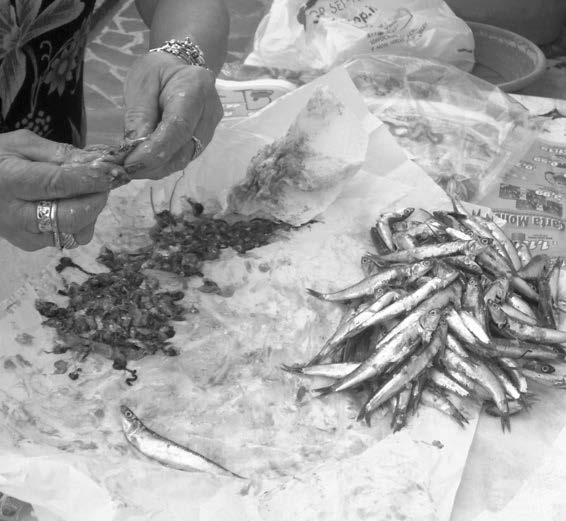
Fig. 7 Blue fish cleaning
Bluefish and mackerels were partially cleaned (Fig. 7-8) – intestines were only taken from the bluefish, whereas fishbone, intestines and gills were taken away from mackerels – and cut into small pieces (Fig. 9-10).
It was felt that, considering the small dimension of the vase, cutting the fish would aid the process.
Salt was carefully chosen to prevent contamination from industrial chemical substances. We used whole organic marine salt naturally gathered from Trapani (Sicily).
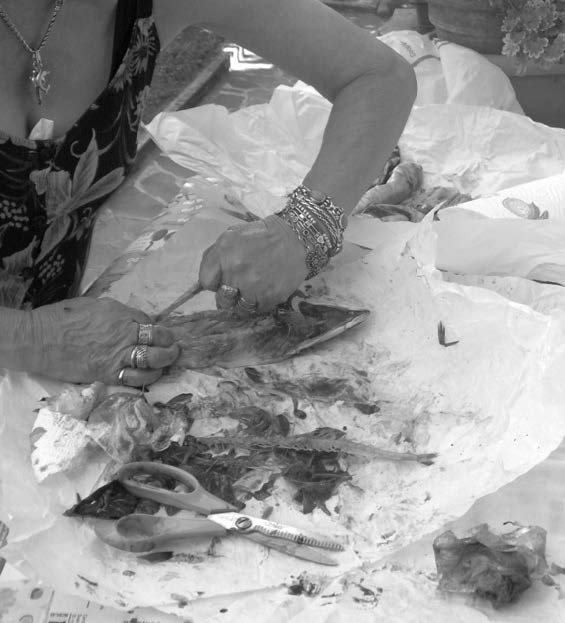
Fig. 8 Mackerels cleaning
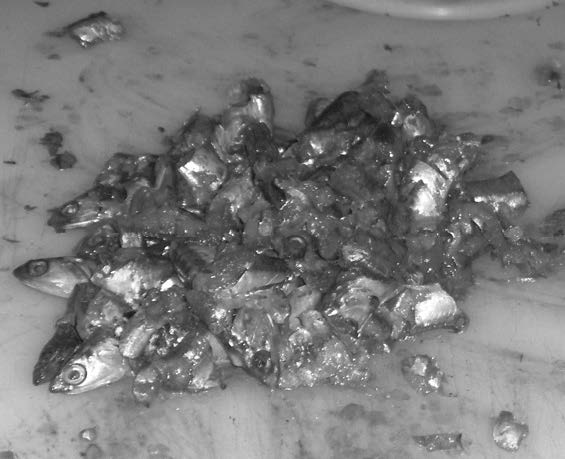
Fig. 9 Minced blue fish
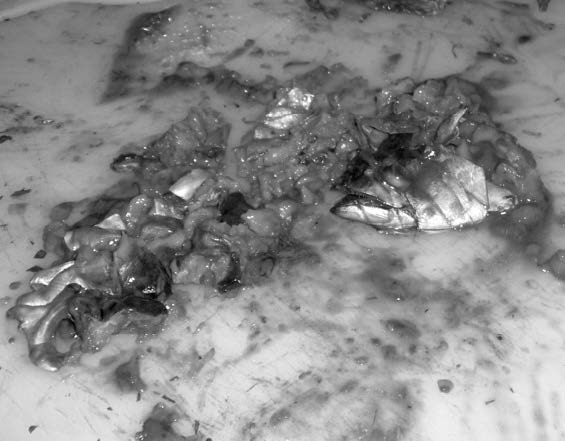
Fig. 10 Minced mackerels
The actual procedure of preparing garum, started with a bottom layer of herbs (Fig. 11) of 2/3 cm height being put in the vase complete with celery (Fig. 12).
Fish was then laidin a layer 3/4 cm high (Fig. 13).
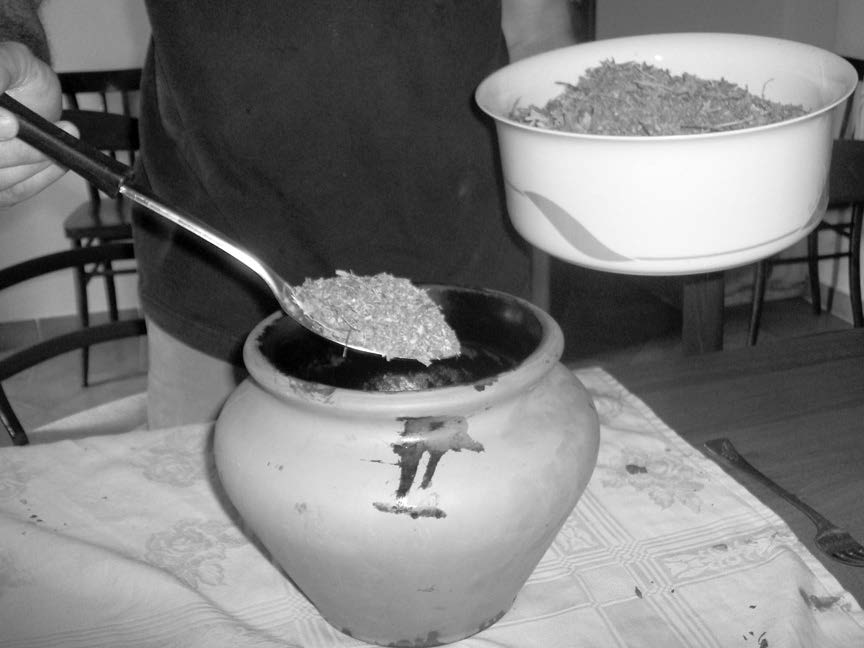
Fig. 11 The first layer of dried herbs
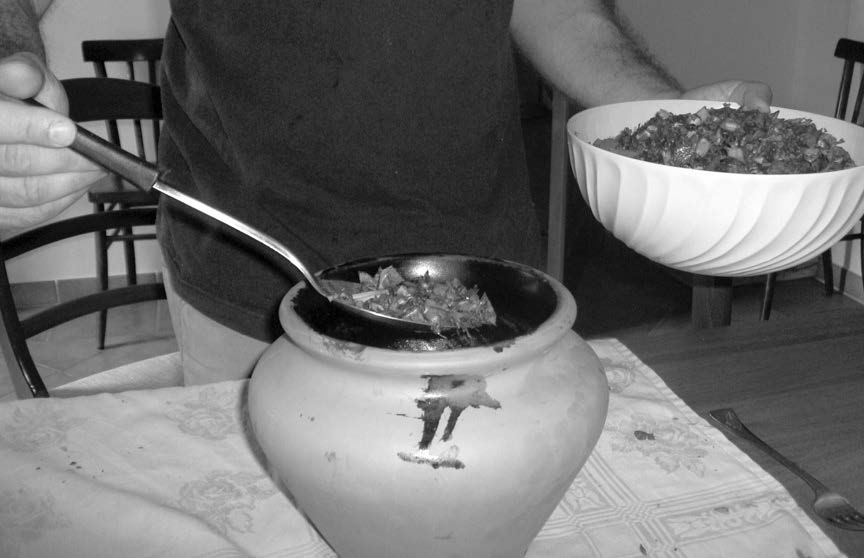
Fig. 12 The first layer of celery
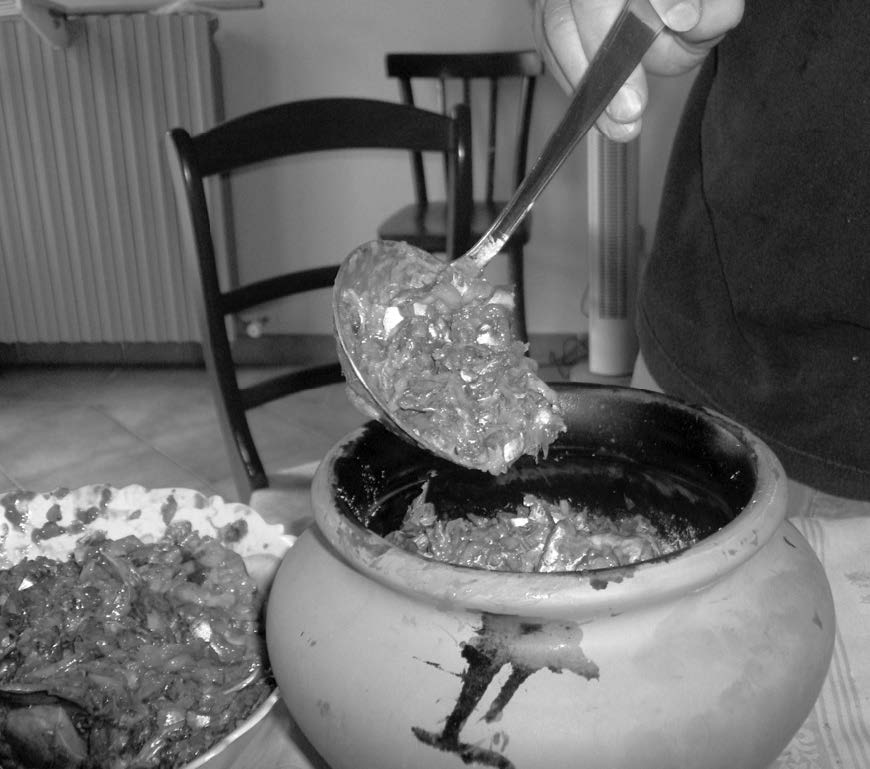
Fig. 13 The first layer of fish (one of three )
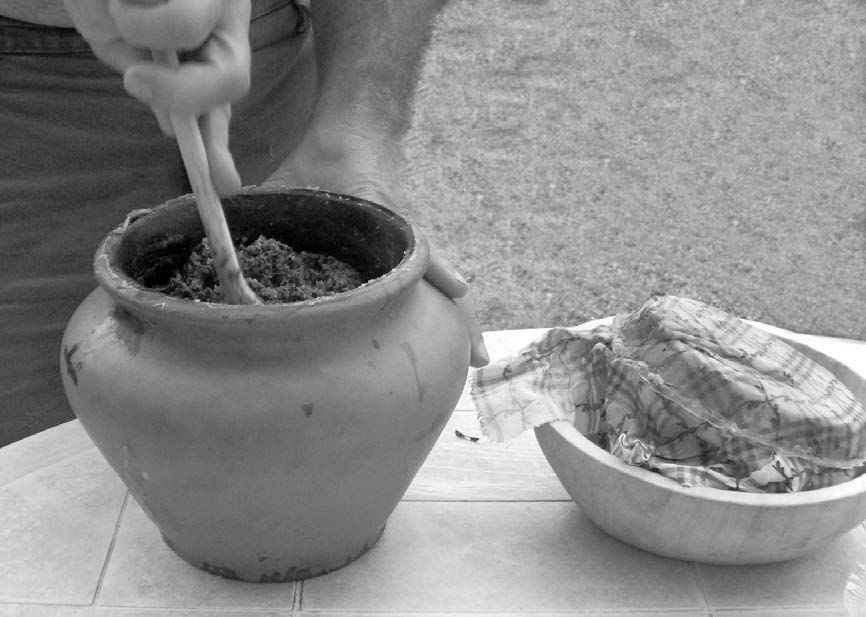
Fig. 14 Stirring with a wooden spoon
The next layer was salt, “two fingers in height” as Martialis says (3/4 cm).
The vase contained 9 layers in total and then was closed with the above described cap. The preparation ended at midday on the 15th August 2008. For the whole duration of the experiment (until 13th September) the vase was left in the sun from just after dawn to a little before sunset.
The temperature reached above 30 ºC. For only two days bad weather prevented the vase to be exposed.
After 7 days excluding the first, the vase was opened to begin stirring (Fig. 14)
On this occasion an intense perfume of fish and Mediterranean spices was released from the compound. The volume seemed to be diminished by 0,2 l and a liquid part was noted among the cloggy compound. For seven days the garum was stirred daily, whereas for the remaining two weeks it was stirred only 3 to 2 times per week.
On the third day of stirring, a yellowish liquid begun to leak from a fissure in the vase. This yellowish liquid had a very acrid smell and become crispy on drying. The fissure in the vase, probably caused by the hardening of the tar within using the flame, was sealed with natural beeswax. The liquid started then to turn into a more greenish colour, probably because of the herbs.
After 28 days, the compound was taken out of the vase and put into a fine linen cloth with medium large texture and compressed to extract the liquid. This method proved to be a failure as the amount liquid was very small and too dense to drip from the cloth. This made us think that a slow dripping method might be more effective as described in the Geoponica. The mixture was then suspended in a natural fibres basket from which to extract the liquamen.
A small amount of garum was indeed collected and tasted. The taste resembled that of anchovy paste with a strong accent on raw fish and a background of spices which made it quite pleasant. At the organoleptic examination the product obtained with the experiment turned out to have the following characteristics:
Consistency: granular with fragments of spices and salt to which the fish are amalgamated.
Colour: olive green.
Smell: the blue fi sh one is predominant, rounded off by spices. Smells are well amalgamated.
Taste: very intense salt and fatty fish, the initial impact vanishes fairly rapidly with the dissolution of salt, leaving a clean aftertaste.
(Examined by Cristiana Minelli, laboratory technician for food industry)
There are few conclusions that we can point to at this stage of research.
The preliminary experiment, in fact, lead us to evaluate many other possibilities in experimenting with garum making. The procedure we used was not successful as very little liquid sauce was obtained. Among the many explanations, lack of extra viscera (besides the utilized fish ones), an over abundance of salt and doubt on the scaled proportion used are to be explored deeper.
As said above, viscera from the fish could aid the autolysis process.
Salt could also be kept at a lower percentage of the total (being almost-at volume 1:1 in our procedure) or, more likely, added in form of brine as happens in Oriental fish sauces and as probably happened in the fish-salting industries in ancient times. Another point seems to be the overall quantity of ingredients, probably standardised at the times of the description for the success of the procedure.
This experiment lead us to distinguish the different variables present in the process, some of which came to light by accident during the experiment itself. For example, we felt that the failure of the process of extracting the liquid was due to the need for a different technique: probably the original recipe for the colatura di alici, using weight put on top of the anchovies, could have helped. Temperature was not a problem as the experiment had been planned for a season in which weather was hot and sunny. Probably air has to be considered carefully in the next experiments in relation to the autolysis.
There is another question regarding the relation between allec and garum, and garum to liquamen.
Sources of the time seem to distinguish between different consistencies.
The archaeological record could be analysed to assess whether there exists a distinction in the container morphology which could be linked to ceramic morphology, content and production procedure.
Customer Care
O CAN THE CAN utiliza cookies para lhe proporcionar uma melhor experiência online. Ao continuar a sua visita ao nosso site, concorda com a utilização de cookies.
Contact
reservations@canthecan.net
info@canthecan.net
T. +351 914 007 100
T. +351 218 851 392
Terreiro do Paço 82/83
1100-148 Lisboa – Portugal
Open everyday from 9:00 AM to 1:00 AM